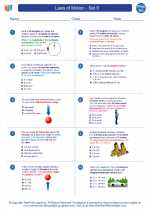Equilibrium in Physics
Equilibrium in physics refers to the state of an object when the net force acting on it is zero and the object is either at rest or moving with a constant velocity. Equilibrium can be either static (when the object is at rest) or dynamic (when the object is moving with a constant velocity).
Conditions for Equilibrium
An object is in equilibrium if the following conditions are met:
- Net Force: The vector sum of all the forces acting on the object is zero.
- Net Torque: For rotational equilibrium, the net torque acting on the object must also be zero.
Types of Equilibrium
There are two main types of equilibrium:
- Static Equilibrium: This occurs when an object is at rest and the net force and net torque acting on it are zero.
- Dynamic Equilibrium: This occurs when an object is moving with a constant velocity and the net force and net torque acting on it are zero.
Examples of Equilibrium
Some common examples of equilibrium include:
- A book resting on a table in static equilibrium.
- A car traveling at a constant speed on a straight road in dynamic equilibrium.
Study Guide for Equilibrium
When studying equilibrium in physics, it's important to understand the following concepts:
- The concept of force and torque.
- Free body diagrams to analyze forces acting on an object.
- The conditions for static and dynamic equilibrium.
- Applications of equilibrium principles in real-world scenarios.
Be sure to practice solving problems related to equilibrium, including calculating net forces, determining torque, and analyzing systems in equilibrium.
Understanding equilibrium is crucial for various topics in physics, including mechanics, statics, and dynamics.
By mastering the concept of equilibrium, you will be able to analyze and predict the behavior of objects at rest or in motion, and apply these principles to engineering, architecture, and other fields.
Good luck with your studies!
.◂Physics Worksheets and Study Guides High School. Laws of Motion - Set II

 Worksheet/Answer key
Worksheet/Answer key
 Worksheet/Answer key
Worksheet/Answer key
